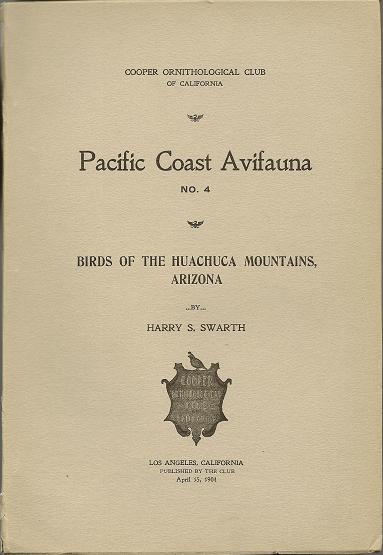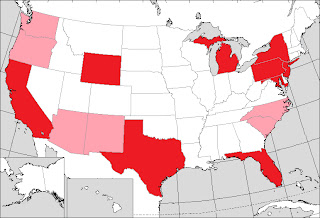Field Guide to Birds: (insert state's name here)
by National Geographic
2004 - 2006, about 270 pages each
Basics: softcover; 12-volume series of small (6 x 4 inches) photo guides with about 270 pages; each book addresses 160-170 of the states' more commonly seen or notable birds of which 125 are shown in very nice photographs; geared towards the casual or beginning birder and towards any birder that may like nice photos; basic text covers description, habitat, and behavior; 4-colored range map provided for each bird
A set of books can be alluring, sometimes more so merely because it is a "set" that is involved. Something created in a "set" implies that collecting should take place; thus, we (at least, I) buy them. This quirky obsession is probably shared to some degree by other birders who practice collecting habits through the maintenance of a yard list, a state list, a life list, a hit-by-the-car list, or some other variation.
National Geographic has created a set of books, a dozen to be exact, where each introduces the reader to birds of a particular state. Each book carries a similar title -- "Field Guide to Birds: (insert state name here)". The dozen books actually cover 15 states. Three of the books address two states each (e.g., AZ & NM, WA & OR, NC & SC). See a map below of the states included within these books.
What's shown inside these small-sized books?
 |
| Texas |
Each little book, or booklet, contains 160-170 birds (about 30-40% of all birds found in the state). Only 125 are shown with a photograph. These 125 "core" birds are displayed in a single, good quality, color photograph that covers between a half and a full page. Nearly every bird is shown by only one individual which is typically the adult breeding male. Although this can help make for a colorful book, it also acts as one of the elements preventing this book from being a complete field guide for any state. Besides showing only 30-40% of the state's birds, these books show only 20-40% of the plumages one could expect to see in the field.
The remaining 50-60 species not shown in a photo might be deemed as "token" inclusions. These additional birds are illustrated in tiny (2-3cm) color drawings tucked in the lower corner of the page. These extra birds are typically a species similar to or reminiscent of the one shown in the adjacent photo. Examples would include pairings such as Summer and Scarlet Tanager; Common Yellowthroat and Yellow-breasted Chat; or White-crowned and White-throated Sparrows.
 |
| New Jersey |
As one might expect, many of the same species are shown in several different books. This is notable for wide ranging birds such as the Yellow-rumped Warbler and Red-winged Blackbird. However, it should be pointed out the exact same photo for many of the birds is recycled through different books. At the extreme, 63 of the photos in the New Jersey book are also found in the New York book. That's half of the photos. To me, this equates to buying one-and-a-half books for the price of two. I recognize the financial and logistical ease of doing this, but it would have been nice to at least provide us with different photos of the Northern Cardinal or the Slate-colored Junco or the other 61 birds. There are so many other good photos that could have been displayed.
What's included in the text for each bird?
 |
| Pennsylvania |
For each photographed bird, general material is provided that covers field marks, behavior, voice, habitat, and regions of the states where the bird is typically found. The field marks are relatively simple, short comments aimed at providing a minimal description to the novice birder. Where appropriate, descriptions are given for each the male and female plumages. A few other comments are usually provided on particular behaviors such as nesting, food, displays, or vocalizations. A few short lines also address habitat.
Each of these birds is accompanied by a range map of the state. Four different colors in the map represent breeding (red), winter (blue), migration (green), and year-round (purple). Additional information on location includes references to a few local sites where the bird may be found. This often lists specific names of places such as "Marsh Creek State Park"; or, perhaps a more generalized area like "Pocono Mountains". Sometimes, the location is more generalized such as "in forest, woodlands, and suburban parks everywhere."
Regarding the tiny birds painted in the corner of the page, the briefest of notes is provided to draw attention to their similarity to the adjacent photographed bird. These notes provide a few descriptive comments along with maybe a note or two on their habitat and range.
Is it worth buying all 12 books?
 |
| Michigan |
Unless you're into collecting bird books, there is probably no strong reason to purchase all twelve. I say this because even with all twelve at hand, they will not help identify all the birds of the US. But, that was not the designed purpose of these books. Although nowhere is it stated as such, there seems to be two key aims for each book.
One, is to provide the beginning or casual birder a highly attractive series of photographs that would hopefully capture the person's birding interest as well as to strengthen it. Two, is to show many of the more commonly seen birds that may be encountered and to provide information on how to identify the birds. If those were the two aims, then National Geographic did a good job. If they weren't, well, they're welcome to use my thoughts for marketing.
Who will appreciate these books the most?
 |
| Arizona - New Mexico |
This guide will appeal more to the casual or novice birder. It will also be useful to those people who take a fascination with the common local birds that visit their feeders or birds that may be seen during a walk through a local park. I recommend giving this book to a beginning birders to encourage their interest without overwhelming them with the hundreds of species (and thousands of plumages) that exist. Start them off easy with this simplified but attractive guide.
You should consider this compact book to be a beginner's guide that will serve as a nice "first book" for the newly indoctrinated birder. For the more experienced or even semi-serious birder with a greater focus on identification, the limited scope of this book may be disappointing. If a more complete identification is the goal, there are other photo-guides that show all the species plus multiple plumages for gender, age, seasons, and race.
These books are not the perfect field guide but they are a great practice tool for anyone beginning their foray into the birding world.
How do these compare to the other set of state-oriented books by Tekiela?
 |
| Tekiela's Arizona |
Stan Tekiela has created a sort of mass production machine with photo guides dedicated to each US state. As of 2011, he's created a small bird book for all but 5 states (NV, NH, RI, VT, WY). Plus, he has many more on mammals, herps, trees, and flowers.
These books are very similar in nature to the National Geographic books; however, Tekiela's books show more species for the state. Like National Geographic, they display only one plumage which is typically the adult breeding male.
One distraction with Tekiela's books is the "cookie cutter" approach with some birds. As an example, the widespread Yellow-rumped Warbler is shown in many books which is to be expected. However, it is the "Myrtle" race that represents this species, even in some of the western states where the "Audubon's" race dominates. This same mistake is done to other species/subspecies as well. To me, it gives an appearance of simply rotating pictures a bit and producing a new cover to the book with a different state's name. Ah, but that does sound familiar with the 63 photos shared between the New Jersey and the New York books mentioned earlier!
The text is similar and is geared towards the beginning or casual birder. I've found these books to be a handy and appreciated gifts for kids. The photos are attractive and they're simple enough to start them off learning the birds. Even the non-birding parents will enjoy the photos.
What states have a book?
Below is a map showing the 15 states that have generated 12 books. The pink-shaded states are those that have been coupled together into a single book.
The selection of states does a pretty good job of (a) hitting the major variations of the avifauna in the US and (b) covering the populated areas of the country that may be interested in purchasing the books. The complete list of books is as follows:
Arizona & New MexicoCalifornia
Colorado
Florida
Maryland & D.C.
Michigan
New Jersey
New York
North & South Carolina
Pennsylvania
Texas
Washington & Oregon
All of these books are nice little works. They're attractive, easy to thumb through, and, I think, provide just the right amount of information to appeal to those friends of yours who've not (yet) purchased their own set of binoculars but have expressed some interest when asking you about what you find so interesting about "birding".
 The one paragraph of text given for each bird, in both Spanish and English, covers status, identification, and movements. The status reviews the seasonal presence of the bird along with its frequency. The identification material, ranging from 1-3 sentences, is brief but effective. In conjunction with the plates, the material will help identify all but the more difficult of species. The section on movements addresses which weeks or months a bird is expected to arrive or depart during its migration.
The one paragraph of text given for each bird, in both Spanish and English, covers status, identification, and movements. The status reviews the seasonal presence of the bird along with its frequency. The identification material, ranging from 1-3 sentences, is brief but effective. In conjunction with the plates, the material will help identify all but the more difficult of species. The section on movements addresses which weeks or months a bird is expected to arrive or depart during its migration. Helping to define this field guide as unique, the are three types of graphics inserted directly onto the plates and the text pages. These provide information for many of the birds' distribution, seasonal presence, and monthly frequency. The style of map used is typically seen in a breeding atlas. Using a grid over a map of the region, each block of the map is specifically colored to represent one of three statuses: Resident, summer breeder, or winter visitor. Accompanying this map is a horizontal bar representing the 12 months of the year. Each month is colored to denote the seasonal presence of the bird. Lastly, a bar-chart is provided for many of the birds to display the intensity or count of birds seen each month.
Helping to define this field guide as unique, the are three types of graphics inserted directly onto the plates and the text pages. These provide information for many of the birds' distribution, seasonal presence, and monthly frequency. The style of map used is typically seen in a breeding atlas. Using a grid over a map of the region, each block of the map is specifically colored to represent one of three statuses: Resident, summer breeder, or winter visitor. Accompanying this map is a horizontal bar representing the 12 months of the year. Each month is colored to denote the seasonal presence of the bird. Lastly, a bar-chart is provided for many of the birds to display the intensity or count of birds seen each month.




























